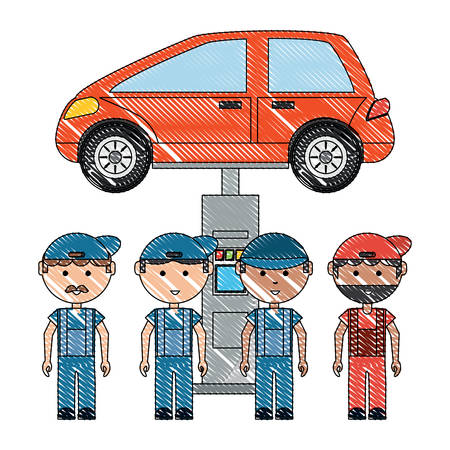Introduction: Landscape of Electric Mobility in Indian Industrial Hubs
India’s journey towards sustainable urban development is intrinsically linked with the rapid expansion of its electric vehicle (EV) sector. Major industrial cities such as Pune, Chennai, and Bengaluru have emerged as pivotal hubs in this transition, driven by a growing awareness of environmental issues and the urgent need to reduce air pollution and carbon emissions. As India strives to meet its ambitious climate goals under international agreements, these cities are not only leading in EV adoption but are also becoming centres for innovation in battery management systems (BMS). The unique combination of dense urban populations, robust manufacturing bases, and dynamic policy environments creates both opportunities and challenges for the deployment of effective BMS solutions. The increasing presence of two-wheelers, three-wheelers, and commercial electric fleets on city roads reflects a shift in public mindset and government priorities. Yet, the success of this transformation depends heavily on how well these urban centres address concerns related to battery performance, recycling, grid integration, and overall ecosystem sustainability. Understanding the localised context—ranging from traffic patterns to climate conditions—becomes crucial in ensuring that EVs deliver tangible benefits for both people and planet in India’s ever-evolving industrial landscape.
2. Understanding Battery Management Systems (BMS) in Indian Conditions
The Battery Management System (BMS) is the backbone of any Electric Vehicle (EV), responsible for ensuring optimal battery performance, safety, and lifespan. In the context of India’s diverse and often harsh urban environments, the role of BMS becomes even more critical. Unlike Western cities, Indian industrial hubs such as Mumbai, Chennai, Pune, and Hyderabad present unique challenges: high ambient temperatures, erratic traffic patterns, heavy industrial loads, and frequent power fluctuations.
Purpose of BMS in the Indian Urban Landscape
A robust BMS in India serves not just to monitor voltage and current but to actively manage battery health under unpredictable conditions. Its core purposes are:
- Safety: Preventing thermal runaway due to extreme heat or overcharging.
- Performance Optimization: Ensuring steady energy delivery during stop-and-go traffic or long idling periods.
- Longevity: Extending battery life amidst frequent charge-discharge cycles typical in Indian commutes.
Key Functions Tailored for India
| Function | Description | Importance in Indian Cities |
|---|---|---|
| Thermal Management | Regulates battery temperature with active/passive cooling. | Counters high ambient heat; essential during peak summers. |
| Cell Balancing | Keeps all cells at similar charge levels. | Prevents premature degradation due to uneven charging in congested traffic. |
| State-of-Charge Estimation | Calculates remaining battery capacity accurately. | Avoids range anxiety for drivers navigating unpredictable city routes. |
| Fault Detection & Diagnostics | Identifies faults, short circuits, or overheating early on. | Cuts down breakdowns in busy areas where roadside assistance is scarce. |
Unique Adaptations for India’s Climate and Usage Patterns
BMS designs are evolving with a local flavour to suit Indian realities. For instance, adaptive cooling systems powered by indigenous technology are now common in EVs operating in Chennai’s sweltering heat or Delhi’s pollution-heavy atmosphere. Furthermore, smart algorithms fine-tune charging cycles based on grid stability—an essential feature given the power surges frequent in many industrial zones. Additionally, dust-proof enclosures and humidity-resistant components extend system reliability during monsoon months or in dusty manufacturing districts like Ahmedabad.
Towards Sustainable Urban Mobility
The development of BMS solutions uniquely tailored for India is a green leap forward. By addressing the nuances of local climate, infrastructure stressors, and cultural mobility habits—such as shared rickshaw fleets or overnight charging in residential colonies—BMS plays a central role in making electric mobility viable for millions across India’s bustling industrial cities.

3. Key Challenges for BMS in India’s Industrial Ecosystems
When studying EV Battery Management Systems (BMS) in Indian industrial cities, one cannot overlook the unique and formidable challenges posed by local environmental and infrastructural factors. The interplay of extreme heat, pervasive dust, unpredictable grid supply, economic constraints, and maintenance hurdles creates a complex landscape for both BMS designers and fleet operators.
Heat: Battling the Subcontinental Sun
Indian industrial regions like Pune, Chennai, or Ahmedabad regularly witness ambient temperatures soaring above 40°C during peak summer months. Such intense heat accelerates battery degradation and puts immense stress on thermal management systems within BMS units. Unlike some temperate climates where passive cooling suffices, Indian settings demand robust active cooling solutions—often increasing both energy consumption and system complexity.
Dust: The Unseen Saboteur
Industrial cities are notorious for high levels of airborne particulates due to ongoing construction, heavy traffic, and manufacturing activities. Dust infiltration can clog battery enclosures, interfere with sensor accuracy, and reduce the efficiency of cooling mechanisms. For BMS deployed in these conditions, enhanced sealing, frequent cleaning routines, and resilient sensor calibration become critical operational mandates.
Grid Irregularities: Navigating Power Uncertainty
The Indian grid is famous for its unpredictability. Frequent voltage fluctuations, load shedding, and unplanned outages challenge not just charging schedules but also the reliability of real-time BMS data logging and remote diagnostics. Fleet operators often rely on diesel gensets as backup—a solution that is neither green nor cost-effective. Thus, BMS in India must be equipped with advanced buffering capabilities and smart algorithms to adapt to erratic power availability.
Cost Constraints: Balancing Affordability and Performance
Affordability remains a defining factor in India’s EV adoption journey. While sophisticated BMS technologies are available globally, their cost often becomes prohibitive for widespread deployment in Indian fleets. Manufacturers are thus compelled to innovate—stripping non-essential features while ensuring core safety functionalities remain uncompromised. This delicate balance between performance and price shapes the evolution of BMS solutions tailored for India.
Maintenance Challenges: Skills Gap and After-Sales Realities
Finally, effective BMS operation hinges on regular maintenance—a task complicated by skill shortages among service technicians in many Indian cities. Rapid urbanisation outpaces technical training initiatives, leading to inconsistent after-sales support. Without proactive interventions from OEMs and local authorities to upskill workers, even the most advanced BMS can falter due to improper handling or delayed troubleshooting.
Together, these challenges highlight why a nuanced understanding of Indias industrial ecosystems is vital when designing or deploying Battery Management Systems for electric vehicles in this rapidly evolving market.
4. Innovations and Localized Solutions in BMS
India’s rapidly urbanizing industrial cities such as Pune, Chennai, and Ahmedabad have become fertile ground for innovative approaches in Battery Management Systems (BMS) tailored specifically for electric vehicles (EVs). Recognizing the unique climatic, economic, and infrastructural challenges found across Indian metros, local startups, research institutions, and indigenous technology developers are making significant strides to deliver robust, affordable, and eco-conscious BMS solutions.
Indigenous Technology: Adapting to Indian Realities
The core of these innovations lies in adapting BMS technology to withstand India’s diverse environmental conditions—from intense summer heat to monsoon humidity—and the often inconsistent power supply. Several homegrown companies are utilizing locally sourced materials and integrating region-specific algorithms that optimize battery life and safety under real-world Indian scenarios.
Key Contributions by Local Startups and Research Bodies
Indian startups like Exponent Energy, Log9 Materials, and Euler Motors are leading the charge with proprietary BMS designs. These systems offer features such as adaptive thermal management, predictive diagnostics suited for congested city traffic patterns, and modular scalability for two- and three-wheeler EVs that dominate Indian roads. In parallel, academic institutions including IIT Madras and IISc Bengaluru are fostering industry collaborations focused on creating cost-effective solutions without compromising on sustainability or performance.
Feature Comparison of Indigenous BMS Solutions
| BMS Provider | Key Innovation | Eco-Conscious Features | Affordability Index* |
|---|---|---|---|
| Exponent Energy | Rapid charging & adaptive cooling | Recyclable materials; energy-efficient design | High |
| Log9 Materials | Proprietary AI-driven analytics | Low-carbon manufacturing process | Medium |
| IIT Madras BMS Lab | Customizable open-source architecture | E-waste minimization protocols | High |
| Euler Motors | Smart range prediction for Indian traffic | Sustainable packaging; low maintenance needs | Medium-High |
| *Relative to imported or legacy systems in the Indian market. | |||
Cultural Impact: “Jugaad” Spirit Meets Clean Tech
A uniquely Indian approach—locally known as “jugaad”—has played a pivotal role in shaping these solutions. This ethos of resourceful innovation is evident in the way BMS technologies are being re-engineered for affordability without sacrificing reliability. The result is not only increased adoption among commercial fleets and last-mile delivery operators but also a positive step towards mass-market electrification aligned with India’s broader environmental goals.
5. Urban Policy and Industry: Driving BMS Adoption in Indian Cities
In the bustling industrial corridors of India, the push for sustainable mobility is closely tied to the synergy between central and state government policies, municipal initiatives, and the proactive role of industries. The deployment and optimisation of Battery Management Systems (BMS) in Electric Vehicles (EVs) are not just technological upgrades—they represent a collective urban mission shaped by policy frameworks, grassroots action, and industry collaboration.
The Role of Central and State Policies
The Government of India’s ambitious FAME (Faster Adoption and Manufacturing of Hybrid & Electric Vehicles) scheme has set the tone for rapid EV deployment. States like Maharashtra, Tamil Nadu, and Karnataka have introduced their own EV policies with incentives for manufacturers, battery producers, and city bus fleets. These policies directly encourage the integration of advanced BMS technology by mandating safety standards, energy efficiency norms, and local R&D investments. For instance, subsidies on EVs often require adherence to certain BMS safety protocols, nudging both automakers and battery companies toward innovation.
Municipal Action at Ground Level
At the city level, municipal corporations in places like Pune, Chennai, and Ahmedabad are rolling out pilot projects that integrate e-buses into public transport fleets. These initiatives prioritize vehicles equipped with robust BMS solutions capable of handling India’s unique climatic and operational challenges. Municipalities also facilitate charging infrastructure planning—often in partnership with private firms—ensuring real-time data integration from BMS platforms for better grid management and vehicle uptime.
Industrial Collaborations: Co-creating Urban EV Ecosystems
Industry players—ranging from legacy automakers to start-ups in Bengaluru’s tech clusters—are forming consortia with research institutes and city governments. These partnerships focus on developing India-specific BMS features such as thermal management suited for high temperatures or algorithms adapted to dense urban driving cycles. Through joint ventures and MoUs, these collaborations enable knowledge transfer, skill development, and even localisation of component supply chains, making advanced BMS more accessible for mass-market EVs.
Together, these multi-layered efforts reflect an emerging ecosystem where progressive urban policy dovetails with industrial dynamism. As Indian cities strive to balance economic growth with environmental stewardship, the strategic adoption of sophisticated Battery Management Systems stands at the heart of this transformation—turning policy blueprints into greener streets across the subcontinent.
6. Future Directions: Building Sustainable and Scalable EV Ecosystems
As Indian industrial cities like Pune, Chennai, and Ahmedabad rapidly adopt electric vehicles, the evolution of Battery Management Systems (BMS) will play a pivotal role in shaping the sustainability and resilience of urban transport. Moving forward, several key strategies can be adopted to create robust and scalable EV ecosystems that address both environmental impact and socio-economic challenges.
Emphasising Green Innovation in BMS Development
To align with India’s ambitious climate goals, future BMS must prioritise energy efficiency, minimised waste, and integration with renewable energy sources. Indian engineers and start-ups are already working on indigenous BMS solutions tailored for local conditions such as high ambient temperatures and power fluctuations. By supporting homegrown R&D through government incentives and public-private partnerships, Indian cities can foster technological advancements that are both sustainable and contextually relevant.
Integrating Circular Economy Principles
A major step towards sustainability lies in embedding circular economy principles within the EV battery lifecycle. This involves designing BMS that enable efficient battery reuse, repurposing, and recycling, thereby reducing dependency on raw material imports and minimising landfill waste. Cities like Bengaluru are experimenting with battery-swapping stations and second-life applications for used batteries in stationary storage or solar micro-grids—a model that other industrial hubs can emulate.
Strengthening Urban Resilience Through Policy & Community Engagement
Urban resilience is not solely about technology but also about inclusive planning. Policymakers need to enact regulations that mandate responsible end-of-life battery management and incentivise eco-friendly BMS adoption among fleet operators and OEMs. Community engagement—ranging from local skill development programmes to awareness campaigns—will be critical in overcoming hesitancy around EVs and establishing a circular ecosystem rooted in Indian values of resourcefulness (jugaad) and collective responsibility.
The Road Ahead: Towards a Greener Urban India
With a focused approach on innovation, circularity, and community-driven action, Indian industrial cities can transform their EV battery management landscape. The journey ahead demands collaborative efforts across industry stakeholders, municipal authorities, start-ups, and citizens. By integrating advanced BMS technologies with holistic urban planning, India can set new benchmarks for environmentally sound mobility while enhancing the quality of urban life for all its people.

